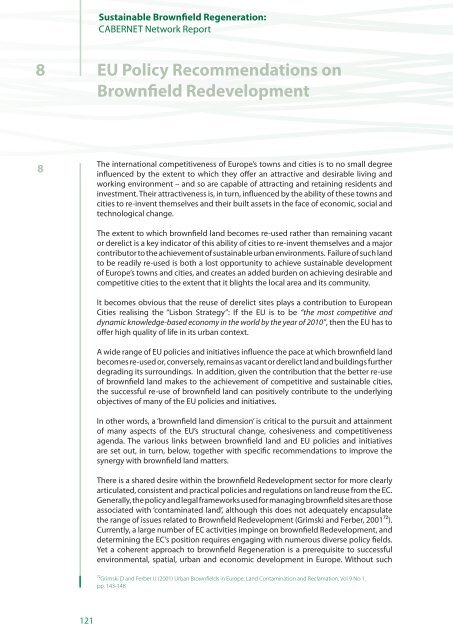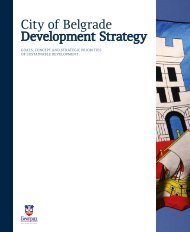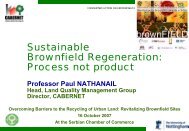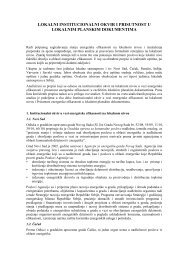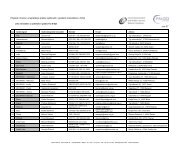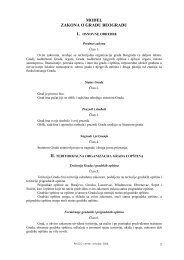Sustainable Brownfield Regeneration: CABERNET Network Report
Sustainable Brownfield Regeneration: CABERNET Network Report
Sustainable Brownfield Regeneration: CABERNET Network Report
You also want an ePaper? Increase the reach of your titles
YUMPU automatically turns print PDFs into web optimized ePapers that Google loves.
<strong>Sustainable</strong> <strong>Brownfield</strong> <strong>Regeneration</strong>:<strong>CABERNET</strong> <strong>Network</strong> <strong>Report</strong>8EU Policy Recommendations on<strong>Brownfield</strong> Redevelopment8The international competitiveness of Europe’s towns and cities is to no small degreeinfluenced by the extent to which they offer an attractive and desirable living andworking environment – and so are capable of attracting and retaining residents andinvestment. Their attractiveness is, in turn, influenced by the ability of these towns andcities to re-invent themselves and their built assets in the face of economic, social andtechnological change.The extent to which brownfield land becomes re-used rather than remaining vacantor derelict is a key indicator of this ability of cities to re-invent themselves and a majorcontributor to the achievement of sustainable urban environments. Failure of such landto be readily re-used is both a lost opportunity to achieve sustainable developmentof Europe’s towns and cities, and creates an added burden on achieving desirable andcompetitive cities to the extent that it blights the local area and its community.It becomes obvious that the reuse of derelict sites plays a contribution to EuropeanCities realising the “Lisbon Strategy”: If the EU is to be “the most competitive anddynamic knowledge-based economy in the world by the year of 2010”, then the EU has tooffer high quality of life in its urban context.A wide range of EU policies and initiatives influence the pace at which brownfield landbecomes re-used or, conversely, remains as vacant or derelict land and buildings furtherdegrading its surroundings. In addition, given the contribution that the better re-useof brownfield land makes to the achievement of competitive and sustainable cities,the successful re-use of brownfield land can positively contribute to the underlyingobjectives of many of the EU policies and initiatives.In other words, a ‘brownfield land dimension’ is critical to the pursuit and attainmentof many aspects of the EU’s structural change, cohesiveness and competitivenessagenda. The various links between brownfield land and EU policies and initiativesare set out, in turn, below, together with specific recommendations to improve thesynergy with brownfield land matters.There is a shared desire within the brownfield Redevelopment sector for more clearlyarticulated, consistent and practical policies and regulations on land reuse from the EC.Generally, the policy and legal frameworks used for managing brownfield sites are thoseassociated with ‘contaminated land’, although this does not adequately encapsulatethe range of issues related to <strong>Brownfield</strong> Redevelopment (Grimski and Ferber, 2001⁷²).Currently, a large number of EC activities impinge on brownfield Redevelopment, anddetermining the EC’s position requires engaging with numerous diverse policy fields.Yet a coherent approach to brownfield <strong>Regeneration</strong> is a prerequisite to successfulenvironmental, spatial, urban and economic development in Europe. Without such⁷²Grimski D and Ferber U (2001) Urban <strong>Brownfield</strong>s in Europe, Land Contamination and Reclamation, Vol 9 No 1,pp. 143-148121


